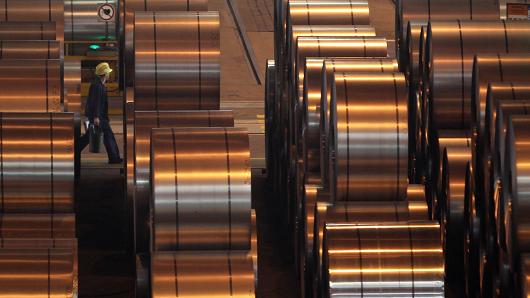Why China steel prices hit record lows
China steel prices are languishing at record lows as persistent concerns over the health of the world's second largest economy bite amid severe overcapacity.
Benchmark steel rebar prices on the Shanghai Futures Exchange hit a record low of 1,733 Chinese yuan (around $272) on Wednesday, down more than a third year-to-date.
With China producing 800 million tons of steel a year—four times more than any other country has ever produced—the sector is in severe overcapacity of some 400 million tons as construction slows in the world's second largest economy.
"A lot of that growth is completely artificially, supported by government policies and subsidies so it's natural to see that sector shrink," Intelligent Investor analyst Gaurav Sodhi told CNBC's Street Signs.
According to the China Iron and Steel Association, apparent steel consumption in China, the world's biggest producer and consumer, fell 5.7 percent to 591 million tons in the first 10 months of the year.
The slump in steel prices is also hitting the price of raw material iron ore. Iron ore for delivery into Qingdao is trading around $45 a ton, near an all-time low of $44.10 reach in August.
There is little upside on the horizon.
Although chart-based cues suggest that the metals complex is oversold, "Chinese steel mills are not looking at these as a reason to buy iron ore, nor are big consumers of oil and copper seeing this as a reason to buy either. This does appear to be a price trap as the fundamentals scream sell and will follow the trend," said IG Markets strategist Evan Lucas in a note Wednesday.
The slump in the steel market forced China's Tangshan Songting Iron & Steel to halt production. The company, with an annual capacity of 5 million tons, is one of China's largest private steel producers.
Chinese social media showed photos of abandoned machinery in mills and workers gathering outside the company headquarters in Tangshan.

Sean Gallup | Getty Images
A worker walks among coils of galvanized steel at a steel factory.
Tangshan, 200 km (124 miles) east of Beijing, produces more steel a year than the U.S., and its tens of small steel mills have been on the frontline of China's campaigns to tackle overcapacity.
The city has pledged to reduce its annual crude steel capacity by 28 million tons from 2013 through 2017, roughly a fifth of its total to reduce the deluge in supply and control air pollution which is caused by coal used in steelmaking.
But with overcapacity continuing, Chinese steelmakers are exporting a large amount of the metal to other markets at low prices, hurting the sector and prompting trade participants to cry foul on what is perceived as dumping.
The U.S., for instance, doubled its on-year growth in steel import volumes from the low 20 percent range to almost 40 percent just in the last few years, even though the country's GDP growth is just 2 percent, Mario Longhi, U.S. Steel CEO, told CNBC's Squawk Box.
"It's really not good for China that they are not addressing it. They really look more at employment and stability in the social environment. They don't have the market rules that guide the way in which business are done over here," he said. "It's not good for them and it's not good for us either because a lot of jobs are being lost, capacity is being reduced. It's a very difficult moment right now," said Longhi.
HEADLINES
- Do shipping markets want Biden or Trump for the win?
- All 18 crew safe after fire on Japanese-owned tanker off Singapore
- Singapore launching $44m co-investment initiative for maritime tech start-ups
- Cosco debuts Global Shipping Industry Chain Cooperation Initiative
- US warns of more shipping sanctions
- China continues seaport consolidation as Dalian offer goes unconditional